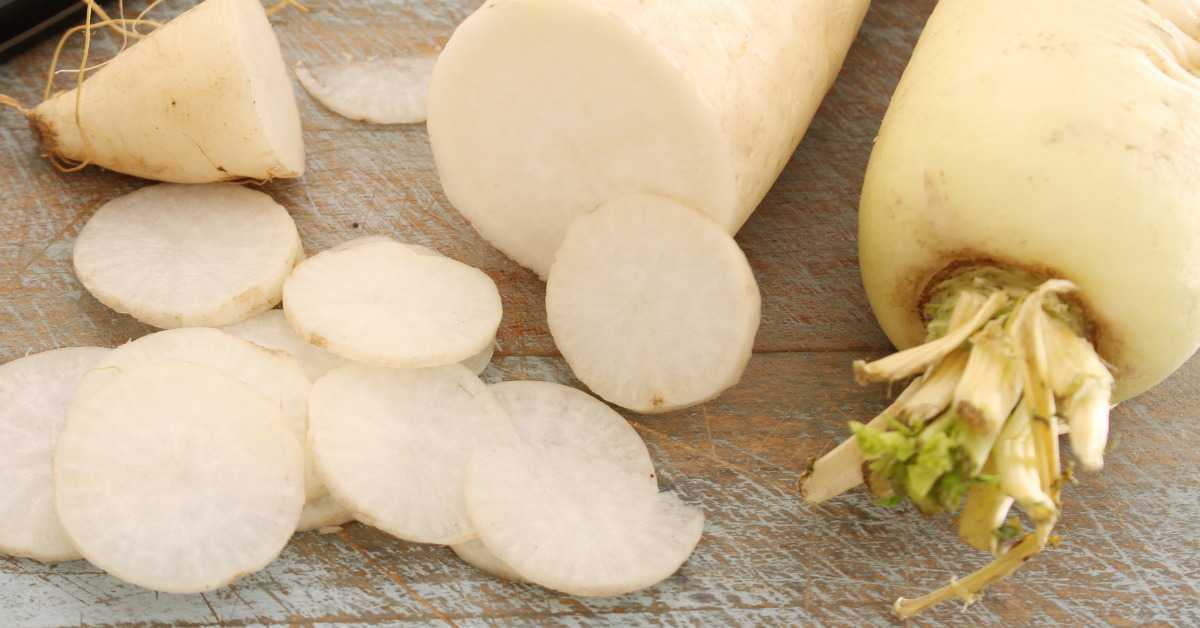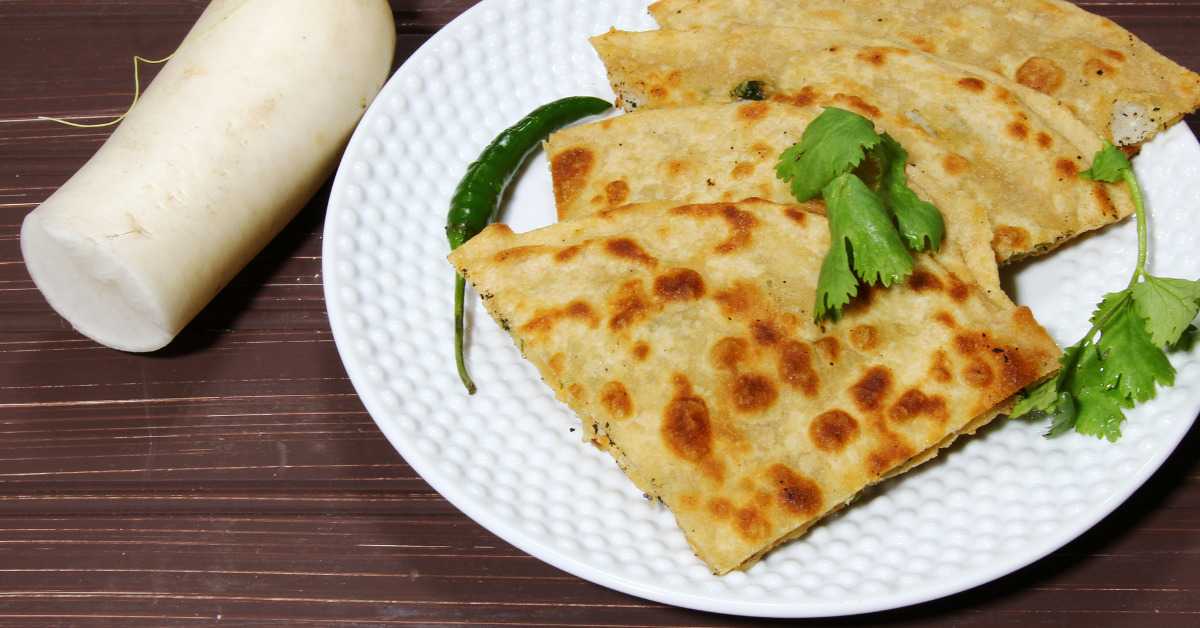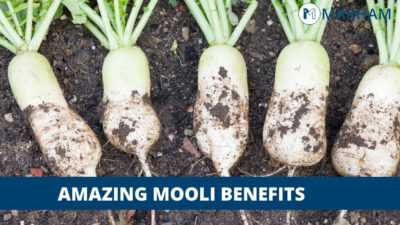Are you curious about mooli benefits? I am sure yes, here you go with the details. Because have you ever been duped into eating something you despise and then grown to like it because of its benefits? My list is or used to be, quite long. And mooli, or rather the humble mooli, was near the top. It would take a lot of convincing to get me to eat it, regardless of how it was disguised – in a curry, parathas, dal, or even a salad.
In addition, there are different types of mooli, some of which grow in the spring and summer and others in the winter. Mooli is a spring-summer vegetable, Pink, and, on occasion, black varieties are also available in Pakistan. Even though not everyone enjoys mooli, it has several health benefits.
For example, mooli aids in cleansing our liver and stomach, thus detoxifying; mooli and its leaves have been used for the longest time to treat jaundice. Because of that property, it also aids in the purification of our blood. They also help to control hypothyroidism due to their high sulfur content. Let’s look at some of the other advantages of this root vegetable.


Amazing Benefits of Mooli
We crave mooli ke paranthe in the winter, as well as salads, pickles, and other cold-weather foods. Not only is this root vegetable in season during the winter, ensuring the best quality, but it has also become a part of how we live and eat during this time of year. So, while we’re sure you’ve been bingeing on mooli or radish-filled dishes, you probably didn’t realize that this veggie improves your health. Here you are going to see some of the health benefits you can get from eating mooli-dominated dishes. Let’s discuss the fantastic mooli benefits;
1. Protects RBCs and High in Fiber
Radish is known to control damage to our red blood cells while increasing oxygen supply to the blood. If you include it in your daily salad without going overboard, radish provides your system with plenty of roughage and fibers, which improves digestion. It also regulates bile production, protects your liver and gallbladder, and benefits water retention.
2. Guards the Heart And Blood Pressure
Radishes are a good source of anthocyanins that keep our hearts functioning correctly, reducing the risk of cardiovascular diseases. Plus, they are high folic acid, vitamin C and flavonoids. Mooli also provides your body to have the ability to control blood pressure, and its ingredients can help you a lot to maintain your blood pressure.
3. Improves Immunity
Because radish contains a high amount of vitamin C, it can protect you from common colds and coughs, as well as improve your overall immunity. However, you must consume it regularly. It also prevents the formation of harmful free radicals, inflammation, and premature aging. Radishes, high in vitamins A, C, E, B6, potassium, and other minerals, can help boost your immune system. Mooli is also high in antioxidants and anthocyanins, which means it’s beneficial to your heart. Of course, you must consume this vegetable regularly to reap the benefits in the long run.


4. Fortifies Blood Vessels
This is important – radish aids in the production of collagen, which strengthens our blood vessels and lowers our risk of atherosclerosis. Radishes, which are high in potassium, can help control blood pressure by maintaining the sodium-potassium balance in the body. This anti-hypertensive property is why everyone should have enough mooli in the winter when high blood pressure problems worsen if not taken care of.
Fights cough and cold while there is no cure for the common cold and the cough that comes with it during winters, radishes can help you fight these ailments. This root veggie has anti-congestive properties, which help clear the mucus from your throat and respiratory tract. So, instead of reaching for a decongestant that’ll make you sleepy, indulge in some mooli.
5. Nutrient-dense and Friendly to the Metabolism
This root vegetable not only benefits your digestive system but also aids in the treatment of acidity, obesity, gastric problems, and nausea, to name a few. Red radishes are high in Vitamins E, A, C, B6, and K. Plus, they are high in antioxidants, fiber, zinc, potassium, phosphorous, magnesium, copper, and calcium. Each of these has been shown to keep our bodies in good working order. You can contact a dietician for involving mooli in your diet.


6. Good for the Skin
If you drink radish juice every day, you’re giving your skin unique antioxidants to keep it healthy, thanks to Vitamin C, zinc, and phosphorus. It also prevents dryness, acne, pimples, and rashes. You can also use radish paste to clean your face.
When applied to the hair, it removes dandruff, prevents hair loss, and strengthens the root. Radishes contain phosphorous and zinc in addition to all of the vitamins. When these are combined, they can aid in treating dryness, acne, and rashes. Furthermore, radishes have a high water content, which helps to keep the body naturally hydrated. If you eat enough mooli, you’ll have glowing skin all winter.
7. Aids Digestion and Hydration
Mooli is chock full of dietary fiber, which helps with digestion issues. If you have enough mooli salad every day, your bowel movement will be smooth. What’s more, you won’t have any constipation with enough intake of radishes. Who knew radish is the secret to a happy and satiated tummy? If you eat radishes more in the summer, it’s probably because their high water content keeps the body hydrated.
How to Cook a Mooli?
As you have seen mooli benefits, now let’s see a bit of cooking a mooli. You’d be wrong if you thought there was only so much you could do with mooli. Aside from slicing it thinly, almost like Carpaccio, If you can’t eat it with salad, there are plenty of other ways to make the most of this vegetable. Making chutneys (such as the famous mullangi pachadi, an Andhra chutney) and curries or a poriyal, stuffing parathas, or even adding it to raita – the possibilities are endless.
For example, you can make mooli slices, mash avocado, and spread generous smears of goat cheese on delicious multigrain bread slices for a quick sandwich – the bite of the mooli and the subtle flavors of the avocado can be a good pairing. Plus, there’s always cheese to round out the flavor. If you’re looking for something warming, try this recipe for radish soup with tofu miso cream. It takes some effort, but the result is quite tasty.


The Bottom Line
Mooli is a high-nutritional-value, low-calorie cruciferous vegetable that may benefit your health in various ways. It may help you maintain healthy body weight and protect against chronic conditions such as heart disease and certain cancers if you eat it. Mooli is not only a very healthy vegetable, but it is also highly versatile. Try this unusual mooli in salads, stir-fries, and curries, or eat it raw as a snack. For knowing its adequate amount, you may contact a dietician.
Book an appointment now to answer all your queries. You can book an appointment with the top nutritionists in Pakistan through Marham by calling the Marham helpline: 0311-1222398 or by online booking facility through the website or Marham mobile app.
Can’t Find The App?
Android Users:
https://play.google.com/store/apps/details?id=controllers.marham.marhammed&hl=en
Drop a review for us at Playstore if you’ve had a good experience!
iPhone Users:
https://apps.apple.com/pk/app/marham-find-a-doctor/id1095243102
Stay Home. Stay Safe!
FAQs
Is Mooli beneficial to the fatty liver?
Radish juice contains compounds that aid in the detoxification and healing of the liver, and these same compounds aid in the elimination of toxins by the kidneys.
Is it safe to consume radishes daily?
Radishes are a *healthy vegetable* to include in your diet because they are high in vitamins and minerals while low in carbs and calories.
Is Mooli safe for the skin?
If you drink radish juice every day, you’re giving your skin particular nutrients to keep it healthy, primarily Vitamin C, zinc, and phosphorus. It also prevents *dryness, acne, pimples, and rashes.
Is radish capable of causing gas?
Artichokes, asparagus, broccoli, cabbage, Brussels sprouts, cauliflower, cucumbers, green peppers, onions, radishes, celery, and carrots are examples of vegetables that can cause excess gas.
Is it true that radish raises uric acid levels?
Many other vegetables have low purine levels. On the other hand, vegetables can help with weight loss because they are low in calories. Vitamin C-rich vegetables include bell peppers, radishes, tomatoes, onions, broccoli, spinach, and cauliflower.
Is it true that radish causes hair loss?
Regular consumption of radish will aid in the prevention of hair loss. When you apply black radish juice to your scalp, it stimulates hair growth and fortifies your roots from within, preventing hair loss.

